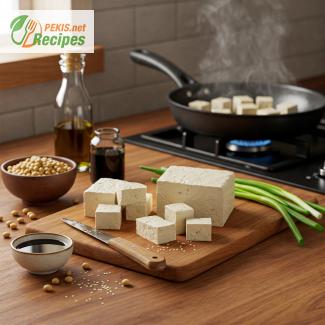
The Ultimate Guide to Tofu: Origins, Nutrition, and Cooking Methods
What is tofu made of?
Tofu, also known as bean curd, is a plant-based protein made primarily from soybeans, water, and coagulants such as nigari (magnesium chloride) or gypsum (calcium sulfate). The process involves curdling soy milk and pressing the curds into solid blocks. Depending on the firmness, it can be silken, soft, firm, or extra firm, each type serving different culinary purposes.
How is tofu made?
The tofu-making process starts by soaking soybeans, then grinding and boiling them to extract the soy milk. The milk is then coagulated using natural coagulants, which separate the curds from the whey. The curds are collected, pressed into molds, and left to firm up. The longer the tofu is pressed, the firmer its texture becomes.
Is tofu healthy?
Yes, tofu is a highly nutritious food that offers numerous health benefits. It is low in calories, high in protein, and packed with essential minerals like iron, calcium, and magnesium. Tofu is also a good source of isoflavones, plant compounds known for their antioxidant properties. However, some concerns exist regarding soy and hormone levels, but scientific research suggests that moderate tofu consumption is safe and beneficial.
Tofu nutrition facts
A 100g serving of firm tofu provides approximately:
- Protein: 8–10g
- Calories: 70–100 kcal
- Fat: 4–5g
- Carbohydrates: 2–3g
- Calcium: 350–500mg
- Iron: 5–6mg
- Fiber: 1–2g Tofu is a nutrient-dense food, making it an excellent choice for those seeking a healthy, balanced diet.
Different types of tofu
There are various types of tofu, each differing in texture and culinary use:
- Silken tofu: Smooth and creamy, ideal for soups, smoothies, and desserts.
- Soft tofu: Slightly firmer than silken, often used in soups and sauces.
- Firm tofu: Holds its shape well, great for stir-fries and grilling.
- Extra-firm tofu: Dense and chewy, best for frying, baking, or grilling.
- Fermented tofu: Aged and packed with umami, used in traditional Asian dishes.
- Smoked tofu: Infused with a smoky flavor, often eaten raw or in sandwiches.
How to cook tofu
Cooking tofu properly enhances its flavor and texture. Some popular methods include:
- Pan-frying: Crisps the exterior while keeping the inside soft.
- Baking: Develops a firm and chewy texture.
- Grilling: Adds a smoky, charred flavor.
- Stir-frying: Perfect for absorbing sauces and seasonings.
- Steaming: Keeps tofu soft and delicate.
Tofu recipes for beginners
If you're new to tofu, start with these easy and delicious recipes:
- Tofu stir-fry: Toss tofu with vegetables and soy sauce.
- Crispy baked tofu: Marinate and bake for a crunchy texture.
- Tofu scramble: A plant-based alternative to scrambled eggs.
- Tofu curry: Simmer tofu in a flavorful curry sauce.
- Tofu smoothie: Blend silken tofu with fruits for a protein boost.
Tofu vs. paneer: What's the difference?
While both are protein-rich, tofu is plant-based, while paneer (Indian cottage cheese) is dairy-based. Tofu is lower in fat and calories, whereas paneer contains more saturated fat and is higher in calcium. Tofu is the preferred choice for those following a vegan or lactose-free diet.
Can you eat raw tofu?
Yes, tofu can be eaten raw, especially silken or soft tofu. It is safe to consume straight from the package, but pressing and seasoning it can improve its taste.
Is tofu gluten-free?
Yes, plain tofu is naturally gluten-free. However, flavored or processed tofu products may contain gluten, so always check labels if you have sensitivities.
Tofu benefits and risks
Benefits:
- Rich in plant-based protein
- Good for heart health
- Supports bone health
- May reduce cholesterol
Risks:
- Allergic reactions in some individuals
- Potential concerns about soy and hormone levels
- Highly processed soy products may not offer the same benefits
Tofu protein content
Tofu contains 8–15g of protein per 100g, making it a great alternative to animal-based proteins.
How to store tofu
To store tofu:
- Refrigerate in water and change it daily.
- Freeze for a firmer texture.
- Use within 3–5 days after opening.
Tofu in vegan diets
Tofu is a staple in vegan diets, serving as a meat substitute and providing essential amino acids.
Tofu vs. tempeh: Differences explained
Tempeh is fermented and firmer than tofu, with a nutty flavor and higher protein content.
Is tofu good for weight loss?
Yes, tofu is low in calories and high in protein, making it ideal for weight management.
Tofu substitutes in recipes
Possible substitutes include chickpea tofu, seitan, or paneer.
Tofu and estrogen: Myths and facts
Soy isoflavones mimic estrogen but do not significantly affect hormone levels in moderate consumption.
How to press tofu
Pressing tofu removes excess moisture, making it firmer and better for cooking.
Tofu stir-fry recipes
Try garlic tofu stir-fry, teriyaki tofu, or spicy tofu stir-fry.
Tofu dessert recipes
Sweet tofu dishes include tofu cheesecake, pudding, and mousse.
Tofu marinade ideas
Popular marinades include soy sauce, miso, lemon-garlic, and sriracha-lime.
Is tofu keto-friendly?
Tofu is low in carbs and suitable for a keto diet.
Tofu shelf life and expiration
Unopened tofu lasts weeks in the fridge, but opened tofu should be used within 3–5 days.
Tofu in traditional Asian cuisine
Tofu is widely used in Chinese, Japanese, Korean, and Thai cuisines.
Tofu and thyroid health
Soy may interfere with thyroid function if consumed in excessive amounts.
Can dogs eat tofu?
Small amounts are safe, but excessive tofu can cause digestive issues in dogs.
Tofu breakfast recipes
Try tofu scrambles, breakfast burritos, or tofu pancakes.
Tofu vs. meat: Nutritional comparison
Tofu is lower in calories and fat than most meats but provides comparable protein.
How to make crispy tofu
To get crispy tofu, press, coat with cornstarch, and fry or bake.
Tofu is a versatile, nutritious, and delicious plant-based ingredient that suits various dietary preferences and cooking styles.